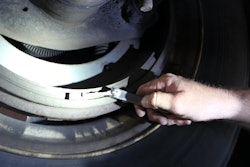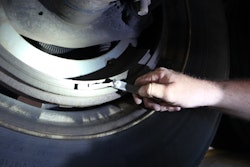Are you seeing broken gear teeth in your shop? Cracked shafts? Burnt bearings? It’s probably not the hardware. More than likely, your customers’ driving habits need adjusting or transmission maintenance practices could use a transformation. A close look at failed internal components can help you tell.
Driver impact
Impact fractures to transmission gears are alarmingly common, and almost always a direct result of improper driving techniques or downright abuse. Such damage occurs when a vehicle is suddenly stopped under load – such as during an accident – or when a wheel spinning on a slick surface suddenly grabs terra firma and transmits a shock load through the drivetrain. It also can happen when a driver “pops” the clutch at elevated rpm on a loaded vehicle. In any case, one gear usually is stopped, and another wants to move it in a hurry. With nowhere for the energy to go, something’s gotta give. Usually, that means “a tooth or teeth are ripped out below the ‘root,'” says Mike Kidd, account and technical training manager, Transmission Technologies Corp. (TTC). Usually, it’s two or more teeth, since the gears are meshed during impact.
The gear shown in Photo 1, sans two teeth, was the victim of impact damage, and the missing-tooth bases display a brittle, granular texture typical of sudden breakage. In a twin-countershaft transmission, “The odds are good that you’ll find similar damage in two places, 180 degrees apart,” says Charles Allen, national service director, ArvinMeritor Commercial Vehicle Systems. “This one was probably the result of an accident.”
Opening a transmission at Southeastern Freight Lines revealed similar damage, as shown in Photo 2. “We’re pretty sure the driver backed under a trailer too fast,” says shop foreman Robert Dominick. “When the king pin seated, he stopped real fast.”
This type of failure often will cause vibration, rattling or knocking, or even complete inoperation of the transmission. In any case, the sooner the symptoms are noted and the transmission opened up, the better. Dominick and others recommend that, when teeth are missing, the entire transmission should be cleaned and inspected, since even a single piece of stray metal can take a fluid-borne joyride around the rest of the components, leaving widespread destruction in its wake.
In the event of a shock-related transmission failure, it also should be standard practice to check for evidence of other drivetrain component damage, such as twisted driveshafts, fractured U-joints and differential trauma.
Shifty operation
Another way transmissions can be damaged by drivers is through incorrect or abusive shifting. Forcing or “grinding” gears usually leaves partially damaged teeth that appear polished and shiny like those on the sliding collar in Photo 3. “The operator is very much part of the transmission,” says ArvinMeritor’s Allen. “And it’s important that he shift properly. The electronics in some newer engines can make it difficult to ‘float shift’ without the clutch, and the driver shouldn’t try to force it.”
Here again, the situation can only get worse if allowed to continue. Synchronizers can burn up from torque applied through a range shift without preselecting. Eventually, says Allen, the thrust washers between gears can burn and allow gears to walk out of line. “You can even see impact damage if two gears try to engage at once,” he adds.
On a synchronized, medium-duty manual box, “The worst thing a driver can do is try to shift without the clutch,” says TTC’s Kidd. “The synchronizers are there to try to match up speeds through friction. If you don’t break torque with the clutch, the synchros actually will try to stop the truck, and eventually will burn up in the process.”
Loads & lubes
Overloading and lubrication failures often mimic each other, since their common thread is excessive heat and the damage it causes. That damage can range from mild to wild. The gear-tooth spalling shown in Photo 4, for example, is relatively benign, and could have been caused by poor lubrication or excessive loading.
According to Jim Whitmer, national training manager for Roadranger, spalling is macro pitting – a form of contact fatigue. The pits form irregular craters that cover a large portion of the tooth surface, which distinguishes the phenomenon from progressive or destructive pitting, where pits occur singularly. This gear could have had an inadequate oil film to begin with, or excessive loading could have caused contact stress, which removed film. In either case, the result is metal-to-metal contact, heat and metal removal.
If you see evidence of heat, such as discoloration and scoring in a bearing like the one shown in Photo 5, but not on gears (assuming a direct-drive transmission), it’s a good bet that you’re looking at a low-lube situation, says ArvinMeritor’s Allen. “You’re more likely to see something like this at the upper countershaft, which is further from the oil,” he says.
This type of damage also can result from severe service, such as pulling steep grades, adds Allen. The fix is to add an oil-cooler retrofit kit that reroutes oil to the top of the transmission. In fact, ArvinMeritor requires such a setup for applications over 399 horsepower.
As with any transmission failure, there can be progressive damage if the root cause is not remedied. In this case, a damaged bearing can allow shafts to be located off-center, causing gear failure. The telltale sign here would be several missing teeth, all together in one area.
Now for the wild: The transmission in Photo 6 is the victim of a complete burn-up. While it’s probable that the original problem was low or no lube, the situation has clearly degenerated. Improper lubrication creates heat. Heat breaks down any remaining lube and allows metal-to-metal contact, which produces even more heat, and the downward spiral continues.
The gear teeth show a wear pattern called “apple coring,” which develops when metal melts, and leaves a central, concave depression in the gear teeth. As burn up progresses, notes Allen, an operator usually notices that the vehicle is difficult to shift, and the transmission grinds or growls when in gear.
It should be obvious that using the correct lube, checking seals and maintaining proper lube level are crucial to transmission maintenance. “Know what your transmissions came with,” advises TTC’s Kidd. “If it came with synthetic lube, that’s what to use. Don’t mix ’em up.”
For example, don’t ever use an 80W-90 EP gear lube in a transmission. “It can turn into a kind of grease,” he says. “And its EP (extreme pressure) ingredients can cause synchronizers, which rely on some friction to do their job, to slip and not perform properly. The result will be gear clashing when shifting.”
Got the vibe?
A less obvious enemy of transmissions can be found downstream in the driveline. Improper universal joint cancellation often brings about torsional vibrations which, says Roadranger’s Whitmer, can be violent enough to break low-range synchronizer pins, as shown in Photo 7.
These vibes often are caused by U-joints installed out of phase, but “Improper driveline angles can do it, too,” says TTC’s Kidd. “If you’re running air suspensions, make sure the ride height is correct. If your shift lever – which is like a transmission’s tuning fork – is buzzing while the truck is moving, consider it an early warning of torsional vibration problems.”
It may seem strange that something well outside a transmission can cause its demise but, as Kidd reminds us, “You have to look at the whole picture.”
“You can’t just look at one broken part,” agrees ArvinMeritor’s Allen. “You have to understand how the parts interacted. It’s like a puzzle.”
And remember, with the specter of progressive damage ever present, the longer a condition remains unchecked, the more likely the original problem will be masked by secondary failures. So get in there early, solve some puzzles – and save some transmissions.









